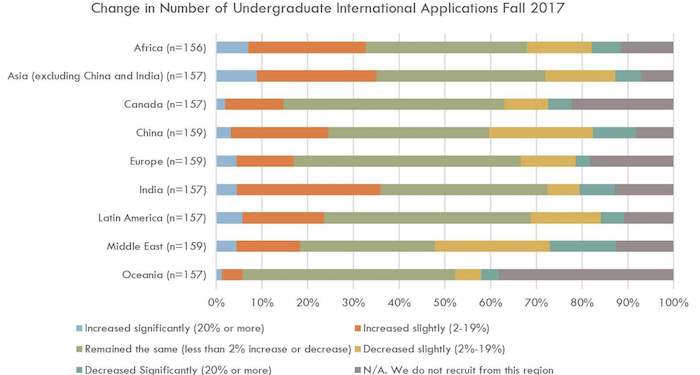Four in 10 educational institutions in the US have reported a decrease in the number of international applicants for the fall 2017 intake, according to responses from an inter-associational survey.
News and business analysis for Professionals in International Education
Have some pie!
International applications down for 40% of US HE institutions, survey reveals
 A quarter of institutions who responded to the survey found a decline in undergraduate applications from China and India. Photo: AACRAO
A quarter of institutions who responded to the survey found a decline in undergraduate applications from China and India. Photo: AACRAO Application unease is high in the US’s top student markets – China and India – but universities report concerns are highest among students in the Middle East. Seemingly negative perceptions of the US as a study destination are also mirrored in a separate survey of international education agencies.
Released by the American Association of Collegiate Registrars and Admissions Officers, the survey on US education institutions was conducted in partnership with IIE, International ACAC, NACAC, NAFSA, and the College Board.
“International educators expressed concern that the political discourse … could be damaging to international student recruitment efforts”
The preliminary findings of the survey, which consists of responses from 250 institutions, aimed to gauge international applicants’ perceptions of the US.
China sent 328,547 students to the US in 2015/16, accounting for almost 32% of all international students, according to Open Doors data. However, a quarter of institutions who responded to the survey found a decline in undergraduate applications from China, and 32% cited a decline in graduate applications.
India tells a similar story, with 26% of institutions reporting a drop in undergraduate applications, and 15% reporting a drop in applications for graduate study.
As a result of these concerns, over three quarters of institutions (77%) expressed apprehension over application yield.
Corresponding with the top-line results, 39% of responding institutions reported a decline in undergraduate applicants from Middle Eastern students while 31% reported a comparable decline for graduate applicants.
The Middle East was also the region where student concerns around studying in the US were especially high, according to 79% of institutions.
Meanwhile, 36% said students in Asia expressed a lot of concern and 34% reported Latin American students.
Perceptions that the climate in the US is less welcoming are high. Students are reportedly concerned that benefits and restrictions around visas could change, including the ability to travel, re-enter after travel, and work.
Not surprisingly, students are also worried the Executive Order travel ban might expand to include additional countries.
There is also a perceived rise in student visa denials at US embassies and consulates in China, India and Nepal, the report found.
Still, 35% of institutions reported a rise in international applications, while just over a quarter (26%) of total respondents stated no change in application numbers.
“Over the past year, international educators expressed concern that the political discourse surrounding foreign nationals in the US leading up to the November 2016 US presidential election could be damaging to international student recruitment efforts,” the report states.
“This survey was intended to be a snapshot of student/family perceptions and institutional activities as opposed to a deep-dive into applicant numbers.” According to AACRAO, a complete and final report will be available by March 30, after a full review of the data.
Still, 35% of institutions reported a rise in international applications
Education agencies also report a deterioration in the perception of the US among students. A recent survey by the American International Recruitment Council of its members found many students are changing their study plans as a result of US governance and policy.
For the 2017/18 intake, 75% of the responding agents said they have seen students change their plans. Close to a third (32%) reported that this is the case for more than 50 student clients – a 15% increase compared to the current academic year 2016/17, according to AIRC.
However, almost a quarter of responding agents (24%) reported no changes in application and enrolment patterns.
Survey results are based on responses from 33 agencies around the world.
Agencies reported that US visa issuance was the top worry among students. But, concerns about the welcoming atmosphere in the US and the potential limitation of work options post-graduation followed closely behind.
Agencies were also asked about alternative study locations other than the US. Fifty-eight percent (58%) said institutions in Canada could meet their student clients’ plan of study; many more than reported for the UK or Australia, AIRC said.
Still looking? Find by category:


